issue contents
July 2010 issue

Cover illustration: The role of a topologically conserved isoleucine in the structure of human GSTA1-1 (Achilonu et al., p. 776).
structural communications
The structure of GTRNase has been solved at 1.60 Å resolution by the molecular-replacement technique.
PDB reference: green turtle egg-white ribonuclease, 2zpo
The results obtained demonstrate the great importance of solvent-inaccessible conserved hydrogen bonds between the Hfq monomers in the stabilization of the hexamer structure.
The crystal structure of bilirubin oxidase (BOD) from M. verrucaria has been determined at 2.3 Å resolution using a merohedrally twinned crystal. BOD has four copper-coordination sites that are almost identical to those of other multicopper oxidases and is also very similar to them in overall structure.
PDB reference: bilirubin oxidase, 3abg
The crystal structure of smu.1377c, a hypothetical protein from S. mutans, shows a similar fold to Sua5_YciO_YrdC-family proteins and indicates its functional role in tRNA modification.
PDB reference: smu.1377c, 3l7v
The role of a topologically conserved isoleucine in the structure of glutathione transferase was investigated by replacing the Ile71 residue in human GSTA1-1 by alanine or valine.
Crystal and solution structures of Rv1848 protein and their implications in the biological assembly of Mtb urease is presented.
PDB reference: Rv1848, 2fvh
The crystal structure of autophagy-related protein Atg8 from the silkworm B. mori has two additional helices at the N-terminus before the expected ubiquitin fold.
PDB reference: autophagy-related protein Atg8, 3m95
crystallization communications
BxlA from Streptomyces thermoviolaceus OPC-520 (molecular weight 82 kDa) was crystallized by the hanging-drop vapour-diffusion method at 289 K.
Crystallization and preliminary crystallographic analysis of the Clostridium perfringens enterotoxin
The crystallization of the C. perfringens enterotoxin is reported.
2.2 and 2.7 Å resolution data sets were collected from crystals of the human apurinic/apyrimidinic endonuclease 1 (APE1) truncated of the first 61 N-terminal residues in the presence of a 15-mer DNA containing an oxidatively damaged base as the target base. For both complexes, APE1 crystallized with a 6-mer DNA, suggesting that nucleotide incision and 3′→5′ exonuclease reactions occurred prior to crystallization.
L-Azetidine-2-carboxylate hydrolase from Pseudomonas sp. strain A2C was crystallized and diffraction data were collected to a resolution of 1.38 Å.
The expression, purification, preliminary crystallization and crystallographic analysis of phosphoketolase from L. lactis ssp. lactis (strain IL 1403) are reported.
Crystallization conditions are reported for an engineered cephalosporin acylase based on the sequence of glutaryl-7-aminocephalosporanic acid acylase from Pseudomonas strain N176.
Two crystal forms of an Mn2+-dependent phosphopentomutase were identified from chemically distinct conditions by sparse-matrix screening with and without the inclusion of 50 mM Mn2+. The crystals identified in the presence of Mn2+ were of dramatically better diffraction quality than those identified in the absence of added Mn2+.
Crystals of the N-terminal domain of nucleocapsid protein from human coronavirus OC43 were obtained that diffracted X-rays to a resolution of at least 1.7 Å.
The chemokine-binding protein from orf virus was purified and crystallized. The morphology and diffraction behaviour of these crystals was significantly improved through the use of additives known as Silver Bullets.
Here, the crystallization and preliminary X-ray analysis of recombinant and purified Magnetospirillum magneticum and M. gryphiswaldense MamA are reported for the first time.
The crystallization and preliminary X-ray diffraction studies of DppA from P. pacifica SIR-I are reported.
The secondary alcohol dehydrogenase mutant I86A from Thermoanaerobacter ethanolicus (TeSADH) was crystallized in novel crystallization conditions. Diffraction data to 3.2 Å were collected at the Canadian Light Source.
Lys48-linked tetraubiquitin, hexaubiquitin and octaubiquitin were enzymatically synthesized, purified and crystallized. X-ray diffraction data sets for tetraubiquitin and hexaubiquitin were collected at 1.6 and 1.8 Å resolution, respectively.
The alcohol dehydrogenase Gre2p from S. cerevisiae catalyses the stereospecific reduction of a variety of different keto compounds and can therefore be applied as a valuable biocatalyst. The crystallization of the complex of Gre2p with NADP+ and its preliminary X-ray analysis are described.
A hyperthermophilic archaeal Rieske-type [2Fe–2S] ferredoxin (ARF) from S. solfataricus P1 has been crystallized as a recombinant protein with a vector-derived long N-terminal extension region. The P43212 crystals of recombinant ARF diffracted to 1.85 Å resolution using synchrotron radiation.
Open  access
access
 access
accessHigh-quality crystals of human haematopoietic prostaglandin D synthase in complex with novel inhibitors were obtained in microgravity.
Cecropin B derived from the hemolymph of Bombyx mori has been crystallized by the hanging-drop vapour-diffusion method. The crystal diffracted to 1.43 Å resolution using X-ray radiation.
The Fab fragment of NC-1, a murine antibody that specifically recognizes the six-helix bundle core of HIV-1 gp41, has been crystallized in space group P3221. An X-ray diffraction data set was collected at 3.2 Å resolution and a clear molecular-replacement solution was obtained for solution of the structure.
The adhesive domain of SdrE from Staphylococcus aureus was recombinantly expressed in Escherichia coli and crystallized. X-ray diffraction data were collected to 1.8 Å resolution.
T. cruzi TcNDPK1 was overexpressed in Escherichia coli as an N-terminally poly-His-tagged fusion protein and crystallized.


 journal menu
journal menu











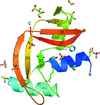
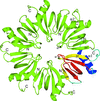




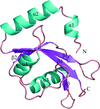






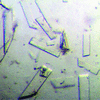










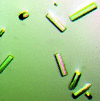
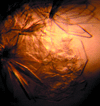


![[publBio]](/logos/publbio.gif)




